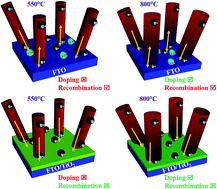Bifunctional TiO2 underlayer for α-Fe2O3 nanorod based photoelectrochemical cells: enhanced interface and Ti4+ doping†
Abstract
A thin, compact TiO2 underlayer for hematite-based photoelectrochemical cells was prepared by simple spin coating and showed a dramatic increase in device performance and photocurrent density. The introduction of TiO2 underlayers induced a noticeable change in the nanostructure. In contrast to the conventional strategies based on underlayers, the compact TiO2 underlayers can act as both a charge recombination barrier and also as a source for titanium dopants. One could simply take advantage of fortuitous doping of Sn from FTO into hematite lattice during the activation step, and is converted into intentional doping of Ti4+ from the TiO2 underlayer into the hematite lattice. Ti4+ doping in hematite lattice is highly probable during the sintering of FTO/TiO2/α-Fe2O3 photoanodes at 800 °C, which has been confirmed by XPS measurements. Based on electrochemical studies, it is evident that the TiO2 underlayer effectively suppresses charge recombination at the FTO/α-Fe2O3 interface and provides possible Ti4+ doping apart from Sn diffusion from FTO substrates when sintered at high temperature (800 °C). In contrast, only charge recombination was suppressed at lower sintering temperature (550 °C). This is the first report on the elemental doping of Ti4+ from the TiO2 underlayer when sintered at high temperature.

- This article is part of the themed collection: 2015 Journal of Materials Chemistry A Hot Papers

 Please wait while we load your content...
Please wait while we load your content...